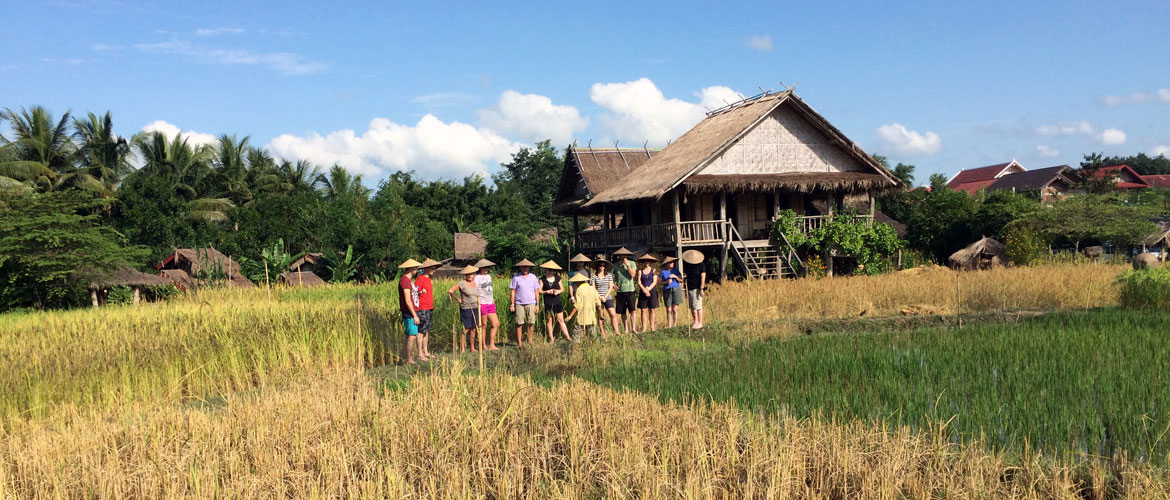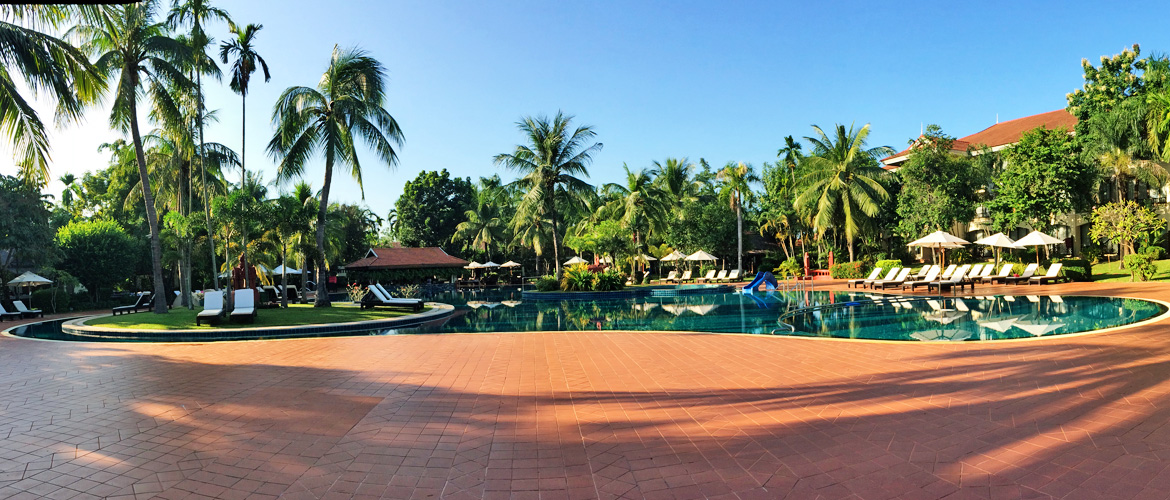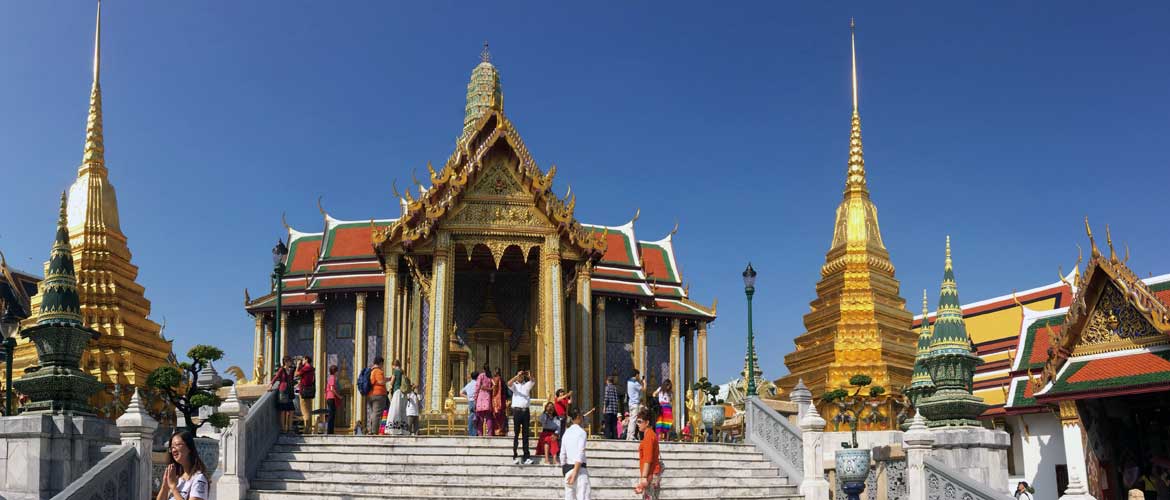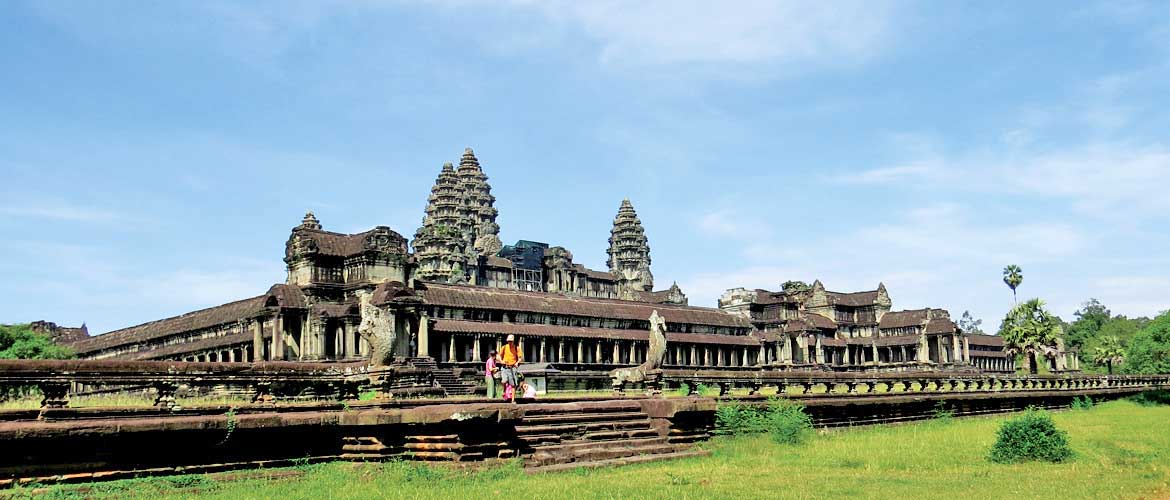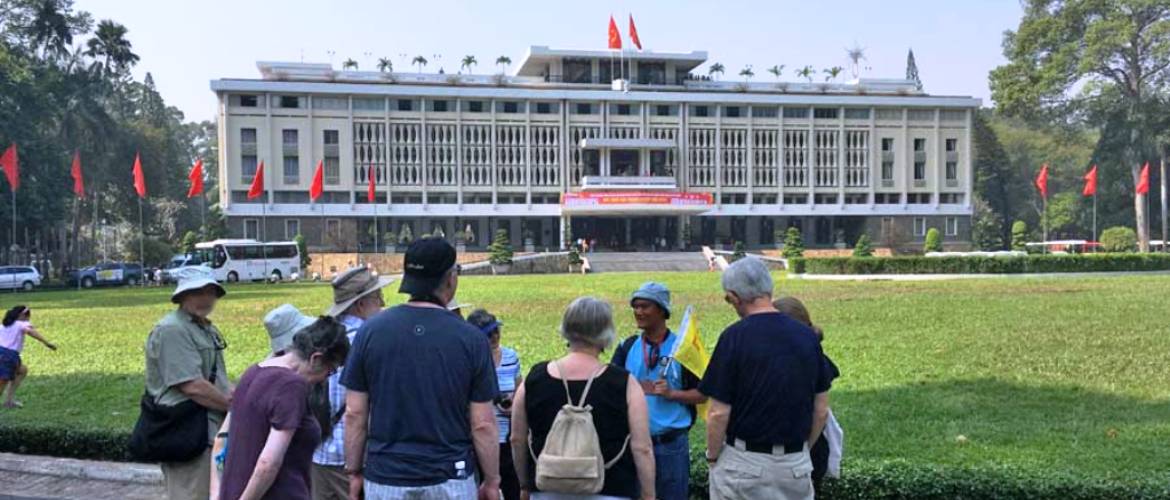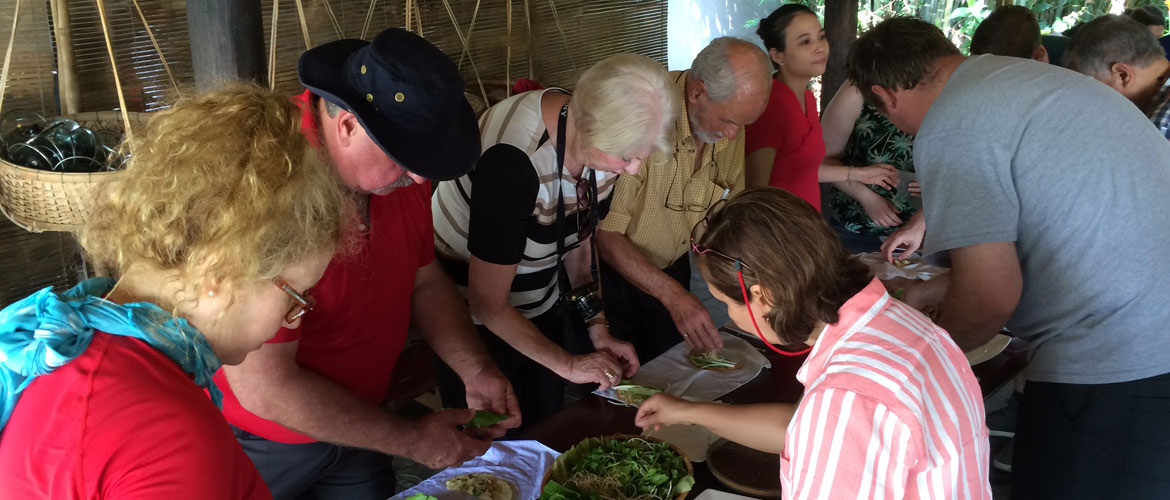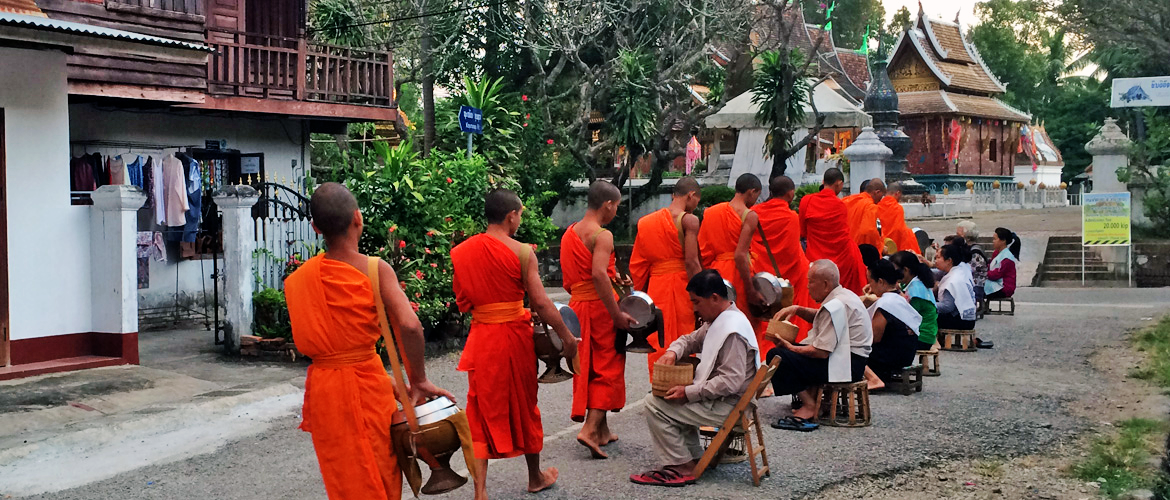Countries visited: Vietnam, Cambodia, Laos, Thailand, Singapore
Hanoi – Ha Long Bay – Hue – Da Nang – Hoi An – Ho Chi Minh City – Phnom Penh – Siem Reap – Luang Prabang – Vientiane – Chiang Mai – Bangkok – Singapore
A grand journey of cultural discovery incorporating the best of French Indochina, Thailand, and the dynamic city state of Singapore, this incredible tour brings you some of Southeast Asia’s top highlights including numerous attractions on the list of UNESCO World Heritage Sites. Key elements of the trip include visits to villages and tasting of authentic local cuisine.
Important Features
- Small group size (average 15, maximum 20).
- Experienced local guides.
- No forced shopping stops.
- Authentic local cuisine.
- Luxury overnight cruise on Ha Long Bay.
- Unlimited supply of bottled water.
- Free Wi-Fi in all hotels.
- Water puppet show in Hanoi.
- Cooking class in Hoi An.
- Village and school visits.
Meal Code: B = breakfast / L = lunch / D = dinner
Day 1/Thu: Departing Home City
The journey begins with your transpacific flight departing from a city of your choice. You’ll lose a day upon crossing the International Date Line.
Day 2/Fri: Arrival in Hanoi
Welcome to Hanoi! Meet your guide on arrival and transfer to the hotel. The remainder of the day is at leisure. Airport transfer for guests arriving ahead of tour schedule is not included and taxi fare is about $15 US.
Day 3/Sat: Hanoi (B/L/D)
Hanoi is the capital and the second largest city of Vietnam with an urban population currently estimated at 4.2 million (2024). The ancient city has had many names throughout history, all of them of Sino-Vietnamese origin. Hanoi received its current name from Emperor Minh Mang in 1831. Ha and Noi mean “river” and “in between” respectively, to reflect the fact that the city sits between Red River and To Lich River. Hanoi was the most important political centre of Vietnam between 1010 and 1802. It was eclipsed by Hue during the Nguyen Dynasty (1802–1945). The city served as capital of French Indochina from 1902 to 1954. After the French were driven out in 1954, Hanoi became the capital of North Vietnam and subsequently capital of the unified Socialist Republic of Vietnam since 1975.
Our city tour following orientation in the hotel takes in the Presidential Palace, Ho Chi Minh Mausoleum, Vietnam National Museum of History, the Old Quarter and a traditional water puppet show.
The Presidential Palace was built between 1900 and 1906 to house the French Governor-General of Indochina. When Vietnam achieved independence in 1954, Ho Chi Minh (1890-1969) declined to live in the grand structure for symbolic reasons. Instead, a traditional Vietnamese stilt house was built for him in the same complex and he lived in it until he passed away. The palace is used for government functions and is off-limits to the public. The Ho Chi Minh Mausoleum is located nearby the palace.
The National Museum of History is housed in the former home of the French School of the Far East (École française d’Extrême-Orient, EFEO for short). EFEO, founded in Hanoi in 1900 and now based in Paris, is a leading institution focused on the study of archaeology, philology, and modern society of East Asia. In 2011, the National Museum merged with the Vietnam Museum of Revolution across the street. This merger expanded the exhibition area to 4,000 square metres and the objects on regular display to over 10,000 with a timeline from prehistory to the establishment of the Democratic Republic of Vietnam in 1945.
The Old Quarter near Hoan Kiem Lake has the original street layout and architecture of old Hanoi. At the beginning of the 20th century the city consisted of only about 36 streets, most of which are now part of the Old Quarter. A night market (near Dong Xuan Market) in the heart of the district opens for business on weekends offering a variety of clothing, souvenirs and food.
We attend a traditional water puppet show later in the day. The show is performed in a waist-deep pool with the surface of water as stage. The puppets are made out of wood and then lacquered. The puppeteers standing behind a split-bamboo screen control the puppets using long bamboo rods and a string mechanism hidden beneath the water surface. The themes are rural, with strong reference to Vietnamese folklore. Stories of harvesting, fishing and festivals are highlighted, often with a humorous twist. Legends and national history are also told through short skits.
We wrap up the day with a delicious welcome dinner.
Day 4/Sun: Hanoi – Ha Long Bay (B/L/D)
Our morning drive to Ha Long Bay takes about two and half hours. Board the luxurious junk on arrival. Our overnight cruise on Ha Long Bay includes visits to a sandy beach and a limestone cave full of stalactites and stalagmites.
Inscribed in 1994 by UNESCO as a World Heritage Site, Ha Long Bay, located in the Gulf of Tonkin and 165 kilometres from Hanoi, covers an area of 43,400 hectares and includes over 1,600 islands and islets. The exceptional scenic beauty of the limestone pillars complemented by biological interest is an ideal model of a mature karst landscape developed during a warm and wet tropical climate. The outstanding value of Ha Long Bay is centered around the drowned limestone karst landforms, displaying spectacular pillars with a variety of coastal erosional features such as arches and caves which form a majestic natural scenery.
Day 5/Mon: Ha Long Bay – Hanoi – Hue (B/L/D)
After a leisurely breakfast, we disembark the boat and drive back to Hanoi. We tour the Temple of Literature after lunch. The temple is dedicated to the Chinese sage Confucius and traces its history all the way back to the year of 1070.
The later afternoon or early evening flight to Hue takes just over one hour. Please note that, if the flight schedule makes it impossible for the planned dinner to be served, it will be moved over to the next day.
Day 6/Tue: Hue (B/L)
Hue was Vietnam’s national capital until 1945, when Emperor Bao Dai abdicated and a communist government was established in Hanoi in the north. During the Vietnam War, Hue’s central location very near the border between the North and South put it in a vulnerable position. In the Tet Offensive of 1968, during the Battle of Hue, the city suffered considerable damage due to a combination of the American military bombing of historic buildings held by the North Vietnamese and the massacre committed by the communist forces.
Our sightseeing in Hue today takes in the massive citadel encompassing the Imperial City, Emperor Tu Duc’s Tomb, and Thien Mu Pagoda. We end the day with an hour-long boat cruise on Perfume River.
Day 7/Wed: Hue – Da Nang – Hoi An (B/D)
Have some free time after breakfast. The late morning drive to Da Nang (92 km) on the winding highway by the South China Sea is simply spectacular. We will make a couple of photo stops before visiting the Museum of Cham Sculpture, a highlight in Da Nang.
Da Nang is a major port city in central Vietnam known for its sandy beaches and French colonial history. During the Vietnam War, what is now the Da Nang International Airport was a major air base used by the South Vietnamese and United States Air Forces.
We continue our overland journey after the museum visit. The drive from Da Nang to Hoi An takes less than half an hour (30 km).
Day 8/Thu: Hoi An (B/L)
The early history of Hoi An is that of the Cham people, who created the Champa Empire which occupied much of what is now central and lower Vietnam, from Hue to beyond Nha Trang. Europeans first reached Hoi An in the early 16th century when it was still known as Hai Fo. In the 18th century, Hoi An was considered by Chinese and Japanese merchants to be among the best destinations for trading in all of Southeast Asia. But its importance waned sharply at the end of the 18th century as a result of domestic turmoil and the rise of Da Nang after the Vietnamese imperial court granted the French exclusive trade rights to Da Nang.
Our morning tour of the food market in the town centre is followed by a cooking class. We then spend the rest of the day exploring the ancient town of Hoi An, a UNESCO-inscribed World Heritage Site. Our walking tour takes in the 400-year-old Japanese Covered Bridge, Sa Huynh Museum, Tran Family Chapel, Phuoc Kien Assembly Hall, and a lantern making workshop.
Day 9/Fri: Hoi An – Ho Chi Minh City (B/L/D)
After breakfast we drive back to Da Nang (30 km) to fly to Ho Chi Minh City (1 ½ hours).
Ho Chi Minh City, HCMC for short, is the largest city in Vietnam, with a population of over 9 million. Formerly named Saigon, it lies 1,160 km (720 miles) south of Hanoi and 605 km (375 miles) southwest of Da Nang.
Ho Chi Minh City began as a small fishing village called Prey Nokor inhabited by the Khmer people, who lived here for centuries before the arrival of the Vietnamese. Beginning in the early 17th century, colonization of the area by Vietnamese settlers gradually isolated the Khmers of the Mekong Delta from their brethren in Cambodia proper and resulted in their becoming a minority in the delta. Increasing waves of Vietnamese settlers, which the Cambodian kingdom could not impede because it was weakened by war with Thailand, slowly Vietnamized the area. In time, Prey Nokor became known as Saigon. Prey Nokor was the most important commercial seaport to the Khmers and the loss of the city and the rest of the Mekong Delta cut off Cambodia’s access to the East Sea. Subsequently, the only remaining sea access for the Khmers was southwesterly at the Gulf of Thailand.
Under the name Saigon, the city served as capital of the French colony of Cochinchina from 1862 to 1954 and later of the independent republic of South Vietnam from 1955 to 1975. Saigon was officially renamed Ho Chi Minh City on July 2, 1976.
Our sightseeing this afternoon begins with a stroll along Dong Khoi Street, formerly known as Catinat Street, the main shopping district and heart of the old colonial Saigon. Highlights include such classic European-style landmarks as Hotel De Ville, the old Opera House, Notre Dame Cathedral and the Central Post Office.
Day 10/Sat: Ho Chi Minh City (B/L)
After breakfast we embark on an excursion to Cu Chi Tunnels. Stretching over 200 km, this incredible underground network was an important Viet Cong base during the Vietnam War. The tunnels were used by Viet Cong soldiers as hiding spots during combat as well as communication and supply routes, hospitals, food and weapon caches and living quarters. The tunnels were also the Viet Cong’s base of operations for the Tet Offensive in 1968.
We return to the city following lunch and spend the rest of the day exploring the War Remnants Museum and the Reunification Palace. Formerly the presidential palace of the South Vietnamese government, the Reunification Palace was stormed by Viet Cong troops on April 30, 1975, signifying the fall of the Republic of Vietnam commonly known as South Vietnam.
Day 11/Sun: HCMC – Phnom Penh (B/L/D)
Depending on the type of aircraft in use, our early morning flight to Phnom Penh can take anywhere between 30 to 45 minutes.
Located at the confluence of three rivers (Tonlé Sap, Mekong and Bassac), Phnom Penh is the capital of Cambodia and also the wealthiest and most populous city in the country. Out of a total population of 17 million, 2.3 million of them live in Phnom Penh.
Phnom Penh first became the capital of Cambodia after Ponhea Yat, king of the Khmer Empire, moved the capital from Angkor Thom after it was captured and destroyed by Siam (Thailand). Phnom Penh remained the royal capital for 73 years — from 1432 to 1505 before it was abandoned for 360 years (1505 – 1865) by subsequent kings due to internal fighting between the royal pretenders. Later kings moved the capital several times and established their royal capitals at various locations in Tuol Basan (Srey Santhor), Pursat, Longvek, Lavear Em and Udong. It was not until 1866, under the reign of King Norodom I (1860–1904), the eldest son of King Ang Duong, who ruled on behalf of Siam, that Phnom Penh became the permanent seat of government and capital of Cambodia again.
Beginning in 1870, the French colonialists built this riverside village into a city with hotels, hospitals, schools, prisons, barracks, banks, public works offices, telegraph offices, law courts and so on. In 1872, the first glimpse of a modern city took shape when the colonial administration employed the services of French contractor Le Faucheur to construct the first 300 concrete houses for sale and rental to the Chinese traders. By the 1920s, Phnom Penh was known as the Pearl of Asia, and over the next four decades the city continued to experience rapid growth with the building of railways to Sihanoukville and Pochentong International Airport (now Phnom Penh International Airport).
During the Vietnam War, Cambodia was used as a base by the Viet Cong’s North Vietnamese Army. Thousands of refugees from across the country flooded the capital to escape the fighting between the various factions, thus increasing the population of Phnom Penh to reportedly 3 million. The Khmer Rouge captured the city on April 17, 1975 and started to forcibly evacuate the entire city soon after. All of its residents, including the wealthy and educated, were forced into the countryside to do manual labour so that they could become “new people” according to the Khmer Rouge. Tuol Sleng High School was turned into a prison camp known as S-21, where people were detained and tortured. Pol Pot sought to transform Cambodia into a self-sufficient agrarian society and therefore killed many people perceived as lazy or political enemies. The Khmer Rouge was driven out of Phnom Penh by the Vietnamese in 1979, and people began to return to the city. Vietnam is historically a state with which Cambodia has had many conflicts; therefore, this liberation was and is viewed with mixed feelings by the Cambodians. A period of reconstruction began, spurred by the continuing stability of government, new foreign investment and international aid.
Our sightseeing today includes the Royal Palace Complex and the National Museum.
Day 12/Mon: Phnom Penh (B/L)
Today we visit Tuol Sleng Genocide Museum and Choeung Ek Killing Fields. These sites may be too much for the visitor to stomach, but they embody an important period in the country’s history no matter how repugnant that period is in our common memory.
Tuol Sleng Genocide Museum is on the same site of the high school turned prison known as S-21. Inside, Khmer Rouge’s torture devices and photos of their victims are on display. If you have read about Tuol Sleng and feel the gruesome scenes may be too disturbing, you may instead opt for a walk through the neighbourhood outside the former high school.
Choeung Ek (The Killing Fields) is 15 kilometers from the city centre. It was one of the mass grave sites of the victims of the Khmer Rouge regime.
Day 13/Tue: Phnom Penh – Siem Reap (B/L/D)
The morning flight to Siem Reap takes 40 minutes. After a light lunch, we visit the Angkor National Museum and Angkor Wat.
The archaeological museum is dedicated to the collection, preservation and presentation of Angkorian artifacts, also to provide information and education about art and culture of Khmer civilization, with collections mainly dated from Khmer Empire’s Angkor period circa 9th to 14th-century. Most of the artifacts are discovered in and around the Angkor archaeological sites nearby. Opened on November 12, 2007, the Angkor National Museum covers the golden era of the Khmer Empire in eight galleries. The museum visit at the beginning of the stay in Siem Reap is designed to better prepare tour participants for what to see next.
Angkor Wat, the modern name for the temple complex, means “Temple City” or “City of Temples” in Khmer. Angkor, meaning “city” or “capital city”, is a vernacular form of the word nokor, which comes from the Sanskrit word nagara. Wat is the Khmer word for “temple grounds”. Angkor Wat was a Hindu temple complex that was later used for Buddhism. It is the largest religious monument in the world. The temple was built by the Khmer King Suryavarman II in the early 12th century in Yaśodharapura (present-day Angkor), the capital of the Khmer Empire, as his state temple and eventual mausoleum. Breaking from the Shaiva tradition of previous kings, Angkor Wat was instead dedicated to Vishnu. As the best-preserved temple at the site, it is the only one to have remained a significant religious centre since its foundation. The temple is embodies the peak of the high classical style of Khmer architecture and has become a symbol of Cambodia, appearing on its national flag and the back of the 20,000-riel banknote.
Angkor Wat combines two basic plans of Khmer temple architecture: the temple-mountain and the later galleried temple, based on early Dravidian architecture, with key features such as the Jagati. It is designed to represent Mount Meru, home of the devas in Hindu mythology: within a moat and an outer wall of 3.6 kilometres in length are three rectangular galleries, each raised above the next. At the centre of the temple stands a quincunx of towers. Unlike most Angkorian temples, Angkor Wat is oriented to the west; scholars are divided as to the significance of this. The temple is admired for the grandeur and harmony of the architecture, its extensive bas-reliefs, and for the numerous devatas adorning its walls.
Day 14/Wed: Siem Reap (B/L)
Visit Angkor Thom and Ta Prohm in the morning and have the afternoon at leisure after lunch.
Angkor Thom (literally: great city) was established in the late 12th century by King Jayavarman VII as the capital of the Khmer Empire. It covers an area of 9 square kilometres and includes several monuments from earlier eras as well as those established by Jayavarman and his successors. One inscription found in the city refers to Jayavarman as the groom and the city as his bride. Angkor Thom was the last and most enduring capital city of the Khmer empire. At the centre of the city is Jayavarman’s state temple, the Bayon, with the other major sites clustered around the Victory Square immediately to the north.
Ta Prohm, originally called Rajavihara, is the modern name of the temple built in the Bayon style largely in the late 12th and early 13th centuries. Located approximately one kilometre east of Angkor Thom and on the southern edge of the East Baray, it was founded by the Khmer King Jayavarman VII as a Mahayana Buddhist monastery and university. Unlike most Angkorian temples, Ta Prohm has been left in much the same condition in which it was found. The photogenic and atmospheric combination of trees growing out of the ruins and the jungle surroundings has made it one of Angkor’s most popular temples with visitors.
Day 15/Thu: Siem Reap (B/L)
After breakfast, we drive 25 km to Banteay Srei (Citadel of Women), a 10th-century temple dedicated to the Hindu god Shiva. The buildings themselves are miniature in scale but the stone carvings are magnificent. On the way back to the hotel, we stop by a village for a better look at the local rural life.
Day 16/Fri: Siem Reap – Luang Prabang (B/D)
We plan to fly to Luang Prabang in the morning but due to limited flight availability we may have to wait till afternoon. It is also possible that our flight includes a brief layover in Pakse, which would stretch our travel time to 3 hours and 20 minutes. Additional activities may be arranged in Siem Reap or Luang Prabang depending on flight schedule.
Modern-day Laos has its roots in the ancient Lao kingdom of Lan Xang, established in the 14th century under King Fa Ngum. For 300 years Lan Xang had influence reaching into present-day Cambodia and Thailand, as well as over all of what is now Laos. After centuries of gradual decline, Laos came under the domination of Siam (Thailand) from the late 18th century until the late 19th century when it became part of French Indochina. The Franco-Siamese Treaty of 1907 defined the current Lao border with Thailand. In 1975, the communist Pathet Lao took control of the government, ending a six-century-old monarchy and instituting a strict socialist regime closely aligned to Vietnam. A gradual, limited return to private enterprise and the liberalization of foreign investment laws began in 1988. Laos became a member of ASEAN in 1997 and the WTO in 2013. The population of the country is estimated to be around 7.5 million as of 2022.
Day 17/Sat: Luang Prabang (B/L)
Strategically located at the confluence of the Nam Khan and Mekong rivers, Luang Prabang is the capital of Luang Prabang Province and the fourth largest city in Laos with a population of 55,000. Laos became a French protectorate in 1893. Following a period of turmoil during which the country was divided into three independent kingdoms, Luang Prabang once again became the royal and religious capital during the reign of King Sisavang Vong (r. 1904- 1945). The city played this role until Vientiane became the administrative capital in 1946. In 1995, the old town of Luang Prabang was inscribed as a UNESCO World Heritage Site as “an outstanding example of the fusion of traditional architecture and Lao urban structures with those built by the European colonial authorities in the 19th and 20th centuries”. The unique, remarkably well-preserved townscape illustrates a key stage in the blending of these two distinct cultural traditions. Luang Prabang is known for both its historical sites and natural beauty.
We rise at dawn to go out and witness an extraordinary ritual – the procession of monks emerging from temples to seek alms from local residents. This traditional food collection ceremony by monks early in the morning, known as tak bat among locals, has become a major attraction to tourists.
After breakfast, we set out for the National Museum, the former royal residence built at the turn of the 20th century. We then visit the Wat Mai, the largest and most decorated Buddhist temple in Luang Prabang. A drive through the scenic countryside leads us to the Tad Kuang Si waterfalls, tumbling over limestone formations to create turquoise-colored pools; the natural footpaths here are perfect for hiking.
On the way back to Luang Prabang, we stop by a Hmong village. The Hmong are an ethnic group from the mountainous regions of China, Vietnam, Laos, and Thailand. During the first and second Indochina Wars, France and the United States governments recruited thousands of Hmong people in Laos to fight against invading military forces from North Vietnam and communist Pathet Lao insurgents.
Day 18/Sun: Luang Prabang – Vientiane (B/L)
We begin today with a visit to a morning market where locals go for their daily food supplies. The exotic spices and food will keep your eyes busy.
After breakfast we drive to a communal rice farm set in idyllic countryside for a better understanding of farming life in this landlocked country. You are invited to try your hand at various farm activities. There is also time to check out nearby workshops of bamboo weavers, blacksmiths and sugar cane processors.
Following lunch, we ride the new express train to Vientiane (2 hours).
Vientiane is the capital and largest city of Laos with a population estimated at around 900,000, roughly 12% of the country’s total of 7.43 million. Vientiane, literally meaning “walled city of sandalwood”, was likely first established as a settlement in the 4th century BCE, though this is still debated by scholars. Vientiane did not gain prominence until 1563 when King Setthathirath (1534-1571), one of the greatest rulers in Laos’ history, made it the capital of the Lan Xang Kingdom (1353-1707).
We spend the afternoon in Vientiane touring Patuxai (a memorial monument inspired by Arc de Triomphe in Paris), Lao National Museum, and COPE Visitor Centre.
Day 19/Mon: Vientiane (B/L)
Free day to explore on your own.
Sightseeing may be arranged if we couldn’t finish everything listed for the previous day.
Day 20/Tue: Vientiane – Chiang Mai (B)
We fly to Chiang Mai today. Depending on flight availability, we might have to return to Luang Prabang to fly to Chiang Mai. If a direct is available at the time of your travel, the air travel time should be just about an hour.
We’ll adjust our sightseeing schedule in Vientiane or Chiang Mai once the international flight is ticketed.
Day 21/Wed: Chiang Mai (B/L)
Nestled in high mountains and 750 kilometres north of Bangkok, Chiang Mai is the capital of Chiang Mai Province. The city was founded as the new capital of the Kingdom of Lan Na (1296–1768) by King Mangrai. Known for its artistic and cultural heritage, the city sits astride the Ping River, a major tributary of the Chao Phraya River. The Chiang Mai Metropolitan Area has a population of 1.2 million, more than half the total of Chiang Mai Province.
The morning walking tour includes Warorot Market by Ping River and the old city centre. We return to the hotel for a rest after lunch.
We spend the rest of the day visiting Wat Phra That Doi Suthep, a Buddhist temple sitting atop the Doi Suthep Mountain about 15 km west of the city. The temple ground offers a panoramic view of Chiang Mai on a clear day and the night view of Chiang Mai from here is simply spectacular.
Day 22/Thu: Chiang Mai – Bangkok (B/D)
Free morning to explore on your own. A visit to the Elephant Rescue Center can be arranged upon request. You’ll have the pleasure watching the elephants taking baths in conditions close to their natural habitat and interact with the gentle giants. We fly to Bangkok later in the day.
Located in the Chao Phraya River delta, Bangkok is the capital and the most populous city of Thailand, with a population of 10.7 million within the city proper or about 15% of the country’s total. The city is known in Thai as Krung Thep Maha Nakhon. A major financial and cultural centre in Southeast Asia, Bangkok also functions as an important hub for airlines serving the region.
Afternoon sightseeing takes place at Wat Arun, a Buddhist temple on the Chao Phraya River. The temple derives its name from the Hindu god Aruna, often personified as the radiations of the rising sun. Wat Arun is among the best known of Thailand’s landmarks.
Day 23/Fri: Bangkok (B/L)
We begin our sightseeing today at the royal Grand Palace. Established in 1782, the palace was dramatically expanded throughout successive reigns. The king and his royal government were based on the grounds of the palace until 1925.
We then proceed to the National Museum, which is the largest museum in Southeast Asia and features exhibits of Thai art and history. This is followed by stops at Wat Pho (a Buddhist temple complex) and Bangkok’s historical Chinatown.
We wrap up the day with an hour-long cruise aboard a long-tail boat on the picturesque Chao Phraya River and the Klongs (canals) of Thonburi on the west side of the river. There will be chances to observe and photograph the serene family homes and temples along the waterways.
Day 24/Sat: Bangkok – Singapore (B)
Free morning to explore on your own.
We travel to Singapore by air this afternoon. Meet your guide and transfer to the hotel. The remainder of the day is at leisure.
Day 25/Sun: Singapore (B/L)
Today’s sightseeing takes in Singapore Botanic Gardens & National Orchid Garden, the National Museum, and historic Chinatown.
The beautiful Singapore Botanic Gardens was inscribed as a UNESCO World Heritage Site in 2015. It is home to some 300 plant species and plenty of birds including oriental pied hornbills, spotted wood owls, crimson sunbirds and stork-billed kingfishers. The tropical rainforest here is one of the few pockets of original jungle left on the island.
Singapore is famous for orchids and the National Orchid Garden is situated on the highest hill in the Botanic Gardens. Orchids have been part of the collections here since the gardens’ beginnings in 1859. Early directors commissioned extensive orchid collecting expeditions and since 1995 the collection has its own beautifully landscaped home – the National Orchid Garden.
We’ll lunch at Halia, a lovely restaurant surrounded by the orchid and heliconia gardens.
Up next is the National Museum of Singapore. With a history dating back to its inception in 1887, the National Museum is Singapore’s oldest museum with a progressive mind. Its galleries adopt cutting-edge and multi-perspective ways of presenting history and culture to redefine conventional museum experience. A cultural and architectural landmark in Singapore, the museum hosts innovative festivals and events all year round. The programming is supported by a wide range of facilities and services including retail and a resource centre. The National Museum of Singapore reopened in December 2006 after a three-year redevelopment, and celebrated its 125th anniversary in 2012. The Museum refreshed its permanent galleries and reopened them on 19 September 2015 for Singapore’s Golden Jubilee.
Finally, we head down to Chinatown Complex to learn about the history of the local Chinese community and taste delicacies from some 260 food stalls.
Day 26/Mon: Singapore (B/L/D)
Today’s itinerary covers Sky Bridge at Pinnacle, Kranji Memorial (cemetery), Bollywood Veggies farm and Gardens by the Bay.
After breakfast, we head for Sky Bridge at Pinnacle. Completed in 2009, the Pinnacle@Duxton is the world’s tallest public housing buildings to date and is comprised of seven 50-storey towers linked by multiple levels of open-air sky bridges. The Pinnacle offers unobstructed views of its surrounding area including Chinatown, the central business district, the busy Singapore harbour and Sentosa Island.
We then drive to the outskirts to explore the Krangi area located at the western tip of Singapore. Full of nurseries and mangroves, this is the only food-producing area in Singapore. We stop by the Krangi Memorial (cemetery) to pay respect to the Allies’ fallen soldiers during World War II.
Afternoon sightseeing takes place at the stunning Gardens by the Bay, a park spanning 101 hectares of reclaimed land adjacent to the Marina Reservoir. The extraordinary project brings to life the vision of the Government of Singapore to make the island city-state a “City in a Garden’. The park consists of three waterfront gardens: Bay South Garden, Bay East Garden and Bay Central Garden. The largest of the three gardens is Bay South Garden, standing at 54 hectares.
Two enormous conservatories and a grove of “Supertrees” dominate the site. Supertree is the name given to the towering, 16-storey structures that act as frames for climbing and epiphytic plants, as well being supports for solar panels. The Supertrees are lit at night in exhilarating displays.
The conservatory complex at the Gardens by the Bay comprises two cooled conservatories – the Flower Dome and the Cloud Forest. The conservatories, designed by Wilkinson Eyre Architects, are intended to be an energy efficient showcase of sustainable building technologies and to provide an all-weather edutainment space within the Gardens. Inside the giant bio-domes are exotic plants collected from South Africa, California, southern Spain, Italy, and southwestern Australia.
There are two distinctly different sets of horticultural themed gardens which centre on the relationships between “Plants and People” and “Plants and Planet”. They are an important part of the Gardens’ edutainment program, which aims to bring plant knowledge to the public. The “Plants and People” theme features a Heritage Garden that highlights the various cultural groups in Singapore and the important role that plants play in their respective cultures, as well as the country’s colonial history.
Day 27/Tue: Singapore (B)
Today is a free day. Please feel free to ask your local guide or tour leader for recommendations.
Day 28/Wed: Singapore – Returning Home (B)
Spend the morning at leisure. Bid farewell to your fellow travellers and transfer to the airport by taxi (cab fare about $20 SGD or $15 USD) for return flight. For guests from North America, you’ll be arriving home the same day after crossing the International Date Line.

Hotel List
| City | Nights | Hotel | Category |
| Hanoi | 2 | Movenpick Hanoi | 5-star/luxury |
| Ha Long Bay cruise | 1 | Paradise Luxury | 5-star/luxury |
| Hue | 2 | Meliá Vinpearl Hue | 5-star/luxury |
| Hoi An | 2 | Hotel Royal Hoi An | 5-star/luxury |
| Ho Chi Minh City | 2 | Caravelle Hotel Saigon | 5-star/luxury |
| Phnom Penh | 2 | La Rose Suites | 5-star/luxury |
| Siem Reap | 3 | Victoria Angkor Resort | 5-star/luxury |
| Luang Prabang | 2 | Victoria Xiengthong or similar | 5-star/luxury |
| Vientiane | 2 | Lao Plaza Hotel | 5-star/luxury |
| Chiang Mai | 2 | Melia Chiang Mai | 5-star/luxury |
| Bangkok | 2 | Sofitel Sukhumvit | 5-star/luxury |
| Singapore | 4 | Amara Singapore | 5-star/luxury |
Dates & Prices
Price based on double occupancy. See Terms & Conditions for cancellation penalty. Scroll down for what the tour price includes and excludes.
| Depart (Thu) |
Return (Wed) |
Land Only CA$/US$ |
Single Supplement CA$/US$ |
| 2025 | |||
| 30-Oct | 26-Nov | $15,960/$11,400 | $4,900/$3,500 |
| 06-Nov | 03-Dec | $15,960/$11,400 | $4,900/$3,500 |
| 13-Nov | 10-Dec | $15,960/$11,400 | $4,900/$3,500 |
| 2026 | |||
| 08-Jan | 04-Feb | $15,960/$11,400 | $4,900/$3,500 |
| 15-Jan | 11-Feb | $15,960/$11,400 | $4,900/$3,500 |
| 22-Jan | 18-Feb | $15,960/$11,400 | $4,900/$3,500 |
| 29-Jan | 25-Feb | $15,960/$11,400 | $4,900/$3,500 |
| 05-Feb | 04-Mar | $15,680/$11,200 | $4,900/$3,500 |
| 26-Feb | 25-Mar | $15,680/$11,200 | $4,900/$3,500 |
| 05-Mar | 01-Apr | $15,680/$11,200 | $4,900/$3,500 |
| 12-Mar | 08-Apr | $15,680/$11,200 | $4,900/$3,500 |
|
What the tour price includes:
|
What the tour price excludes:
See Terms & Conditions for more information. |
Passport
For this tour, you’ll need a passport that has at least four (4) blank visa pages and six (6) months validity at the end of the trip.
Visa
Thailand does not require visa for stays less than 30 days. Vietnamese, Cambodian and Laotian e-visa can be easily obtained online. Please wait till within 30 days of travel to apply and feel free to ask for us for assistance. If you apply on your own, be sure to deal with the appropriate authorities directly and avoid any middleman. Some of the middlemen use domain names ending with .govt.vn or .org to trick the public.
Vietnam Tourist e-Visa: US$25
https://evisa.xuatnhapcanh.gov.vn/
https://www.xuatnhapcanh.gov.vn
Cambodia Tourist e-Visa: US$36
https://www.evisa.gov.kh/
Laos Tourist e-visa: US$50
https://laoevisa.gov.la/
Thailand: Tourist Visa not required
Singapore: Tourist Visa not required. SG Arrival Card (SGAC) (not visa) must be submitted online 3 days prior to your arrival.
https://www.ica.gov.sg/enter-transit-depart/entering-singapore/sg-arrival-card
Immunization
Visitors may be asked to show proof of vaccinations against COVID-19 prior to or on arrival. COVID testing prior to arrival is no longer required.
We are not aware of any other inoculation requirements and we suggest you visit the websites of your national government’s disease control centre and pertinent embassies in your country for the latest. We recommend all of our guests to be vaccinated against hepatitis A.
Tips on Staying Healthy
Do not drink from the tap when you travel. Ask for bottled or boiled water when eating in restaurants. When buying bottled water from street vendors, especially at tourist sites, make sure the cap is properly sealed because some vendors may be selling tap water in recycled bottles.
Try to avoid uncooked food. Raw food, even clean, may still cause stomach upset or diarrhoea.
Always carry a roll of toilet paper and a bottle of hand sanitizer containing more than 60% of alcohol, no matter where you go.
Always have an N95 type of facemask ready. Passengers sitting next to you may be sick and cough loudly but wear nothing to cover their mouth. This was a big problem before the pandemic that may return soon.
Banknotes in general are filthy and carry all kinds of germs. Minimize your contact with local banknotes and coins by keeping them in a plastic bag and sanitize your hands every time you touch them. Use plastic for payment as much as possible.
Currency & Credit Card
Vietnam currency: Dông (VND)
Cambodia currency: Riel (KHR)
Laos currency: Kip (LAK)
Thai currency: Baht (THB)
Singapore currency: Dollar (SGD)
Please keep your inventory of local currencies to the minimum. Your tour fare covers all the expensive items already. You only need some local cash, which can be easily obtained as you go, for souvenirs and meals not included in the tour price.
Consider using a credit card for transactions over $20. Major credit cards such as Visa and MasterCard are widely accepted throughout Southeast Asia. Street vendors in Vietnam and Cambodia prefer U.S. dollars to their own currency but you should exercise caution if you want to play along. Merchants in more prosperous Thailand and Singapore only accept their own currency if you pay by cash.
Reading List
Our recommended reading list for this itinerary is being updated. Please check back with us if you are interested.
Travel Insurance – When to Buy
We will save your deposit as credit if you cancel at any time and for any reason. The transferrable credit has no expiration date. Therefore, it may be unnecessary to pay $30 to $50 on cancellation insurance for your deposit.
However, you should definitely consider purchasing trip cancellation & emergency medical insurance when your balance is due. If you don’t have proper coverage, the loss could be devastating if you were forced to cancel close to your departure date or run into a serious medical emergency during the trip. Please ask us for insurance quotes when your balance is due.
